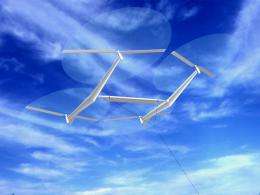Kites flying in high-altitude winds could provide clean electricity

(PhysOrg.com) -- At any moment, the winds in high-altitude jet streams hold roughly 100 times more energy than all the electricity being consumed on Earth, according to a study by Stanford environmental and climate scientists Cristina Archer and Ken Caldeira.
To capture that energy, designers are dreaming up models of wind-turbine kites that fly so high, cruising airliners would have to steer around them. The tethered kites would float high enough for powerful jet streams to flow through their turbines more than 10 times faster than winds would flow near the ground.
The spinning rotors of the kite turbines would convert the wind’s kinetic energy to electricity and send it back down the wire 30,000 feet to a distribution grid.
Harnessing these high-flying currents could open up an effectively unlimited source of electricity, the researchers say. Kites may have the potential to be cost competitive, Caldeira said, and the study shows that the wind resource is huge and relatively reliable.
The researchers reached this conclusion by analyzing 27 years of data from the National Center for Environmental Prediction and the European Centre for Medium-Range Weather Forecasts. By studying the distribution of wind power in the atmosphere, by location and time, they found that winds at altitudes around 32,000 feet have the highest wind power density. “The wind power density tells you how much wind energy would flow through a wind turbine,” Caldeira said.
The researchers used the data to compile the first global survey of high-altitude wind energy. Archer is an assistant professor at Stanford University and California State University-Chico and Caldeira is an associate professor at Stanford and a researcher at the Carnegie Institution of Washington. Their findings were published in the journal Energies last month.
High-altitude winds hold a huge energy potential waiting to be harnessed. “If you tapped into 1 percent of the power in high-altitude winds, that would be enough to continuously power all civilization,” Caldeira said. In comparison, similar solar cells would cover roughly 100 times more area than a high-altitude wind turbine, he said.
Archer and Caldeira found the highest wind densities over Japan, eastern China, the eastern coast of the United States, southern Australia and northeastern Africa. Included in the analysis were assessments of wind energy above the world’s five largest cities: Tokyo, New York, São Paulo, Seoul and Mexico City. “New York … has the highest average high-altitude wind power density of any U.S. city,” Archer said.
Tokyo and Seoul also have high wind power density because they are both affected by the East Asian jet stream. Mexico City and São Paulo are located at tropical latitudes, so they are rarely affected by the polar and sub-tropical jet streams. As a result they have lower wind power densities than the other three cities.
In order to capture the energy in these jet streams, manufacturers are developing a variety of kite turbines that convert kinetic energy in wind to electricity. Manufacturer Sky WindPower designed a model consisting of a single tethered kite of four connected turbines, each with spinning rotors. The kite transfers the electricity back to a hub on the ground through its tether.
Another model, being developed by Kite Gen, looks like a rotating carousel, based on the ground, with several kites tethered to it. Each kite’s flight pattern is controlled from the ground to capture the most wind, and as the kites circle in the air, they catch the wind and tug on their tethers. The tension triggers a pulley system that converts the energy of motion to electricity.
Though sky-high currents offer huge potential, kite fliers face the challenge of a fluctuating wind. “While the winds at high altitude are much more consistent than the winds at the surface, they’re still not consistent enough,” Caldeira said. For example, if you flew a kite turbine in your backyard to power a house, at some times the wind would blow and at other times, it wouldn’t, he said. As a result, there would be gaps in the flow of electricity.
Archer and Caldeira suggest a large-scale electrical grid to transfer excess energy to areas that have more demand than production. “Winds are always blowing somewhere, so if you had a large enough electrical transmission grid you could transmit the electricity from where it is blowing to where it isn’t blowing,” Caldeira said.
Making batteries large enough to supplement the wind fluctuations seems improbable, and backup generators would be expensive, Caldeira explained.
Another minor hurdle may be interference from airplanes. Manufacturers such as Sky WindPower and Kite Gen say that air traffic is not a huge problem. Kite users would simply need to obtain flight restrictions above their air space, just as nuclear power plants and refineries do. Sky WindPower also suggests that kites be flown in areas that are rural but not too far from the urban spots that the researchers identified as high-flow.
Wind kites are not yet in use, but manufacturers predict that the cost of high-altitude wind power will range from 2 to 4 cents per kilowatt-hour.
Provided by Stanford University (news : web)


















